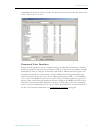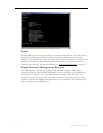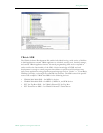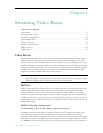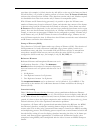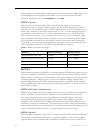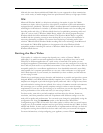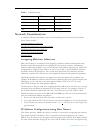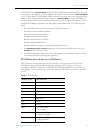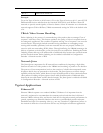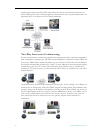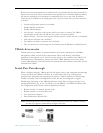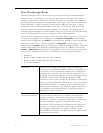
Streaming Video Basics
VBrick Appliance Getting Started Guide 21
kHz and data rates between 8000 and 320000 bits/sec are supported to allow transmission
over a wide variety of media ranging from low-speed Internet delivery to high-speed LANs.
WM
Microsoft Windows Media is a ubiquitous technology that makes it easier for VBrick
customers to deploy video for one-way video delivery to millions of PCs and multimedia-
equipped devices worldwide. "Windows Media" describes Microsoft's multimedia product
technologies for Windows. It includes (1) Windows Media Format tools for encoding and
decoding audio and video, (2) Window Media Services for publishing streaming audio and
video on a server, and (3) Windows Media Player, which is the client program that plays
Windows Media and other multimedia formats. The Windows Media Player is typically
installed with the operating system on most desktop PCs so no player-side installation is
necessary, eliminating a common IT concern when deploying a streaming audio/video
solution. VBrick licensed Windows Media encoding and server technology from Microsoft
and created the VBrick WM Appliance to interoperate with other Windows Media
compatible products including all versions of Windows Media Player and all versions of
Windows Media Server.
Getting the Best Video
Video quality is a subjective concept that depends on a variety of factors. VBrick's
philosophy is to make our network appliances as flexible as possible so they can be used
effectively in different applications on a wide variety of networks. This means you can
configure an appliance for maximum performance but you can also configure it in such a way
that it will only work well in a very limited environment. Video quality is also relative. What is
acceptable quality for a surveillance application on a low-bandwidth network is most likely
unacceptable for a corporate presentation or a two-way video conference on a high-speed
LAN. Much depends on your network, the bandwidth you have available, and the audience
you are trying to reach.
VBrick tries to anticipate as many obstacles and limitations as possible and provides custom-
designed MPEG-4 and WM (Windows Media) templates for a variety of applications. These
templates are designed to provide the highest quality audio and video—using bit rate, frame
rate and resolution settings that are tailored for a variety of common network environments.
We encourage you to override specific template settings in order to meet the unique
requirements of your own site, but in doing so, be aware that you can also degrade the quality
and/or performance of the audio and video you are trying to deliver.
For best results, start with a pre-built template and then adjust the bit rate, frame rate,
resolution, and other parameters with care. Experiment with different settings to see the
trade-offs in quality and performance. You can track your changes by periodically saving the
configuration file using the
Read/Write option on the Maintenance: Read/Write
Configuration page in IWS. If the audio and video quality is still less than you would expect,
re-apply one of the standard templates and try again. Keep in mind that the VBrick is stable,
reliable and flexible. In most cases a small amount of experimentation will help you find the
configuration settings that will deliver the best audio and video your network can support.
For more information, or help configuring your appliance, contact VBrick Support Services
.



